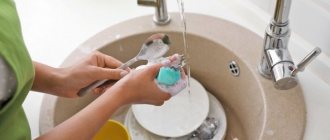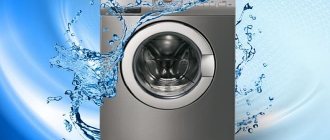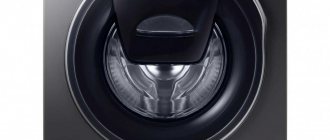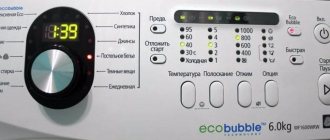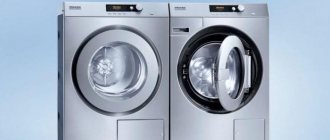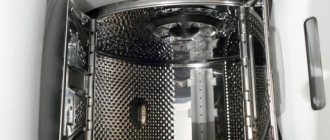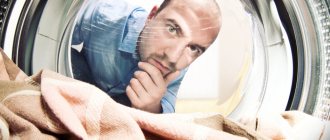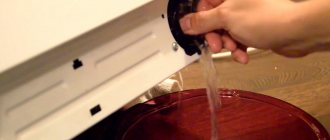The modern rhythm of life does not make it possible to devote much time to household chores, especially since technological innovations make it possible to have a home assistant who can wash and even dry clothes. The buyer should know how much the washing machine consumes and how to use it correctly so that it lasts as long as possible.
What determines how much electricity a machine will consume?
The washing machine's energy consumption will not be the same throughout the entire process. This is influenced by the type of device operating at each stage. For example, the drive, electric motor (heating element) are not in the on state throughout the cycle, but only in periods. Electricity is consumed both when draining water, when the pump is running, and in standby mode, because... The control panel is not disabled at this time.
When heating water with a heating element, an average of 2 kW is consumed. To drain the waste liquid, the unit consumes about 40 W. Control panel background operation will result in a cost of 3 to 10 watts.
But it is worth considering the fact that during active operation the power consumption of the washing machine differs. This is influenced by the program used for washing and the engine speed specified in the settings.
Water is heated at the required times. When the water has reached the selected temperature, the motor turns off. Therefore, the power of the washing machine is not at the same level. High water temperature, increased speed, greater equipment load cause higher consumption.
What components consume energy in washing machines?
How many kilowatts does a washing machine consume when washing? The total value is determined by the level of energy consumption of its main components. These include:
- Electrical engine;
- heating element - heating element;
- drain pump;
- Control block.
The total power of the unit is determined by the sum of the powers of the above parts.
Electric motor
The motor is the main part that rotates the drum and takes on the lion's share of the total energy consumption of the washing machine. Today you can find SMs equipped with one of three types of engines:
- asynchronous;
- collector;
- brushless.
Direct Drive Brushless Motor Stator
Two-phase asynchronous motors are no longer installed on washing machines. The vast majority of AFMs operate on inverter commutator and brushless electric motors. Commutator motors have a short service life due to brush wear. In addition, they are very noisy.
Today, the best models of equipment from brands such as LG, Bosch, Indesit, Siemens, Miele and others are equipped with brushless electric motors. These products consume 20% less electricity, are much less noisy and can operate for more than 10 years without replacement. The motor power of a washing machine ranges from 400–800 W.
heating element
The main function of the heating device is to heat the water in the tank to the temperature specified by the washing program.
Heating element for Samsung washing machine
The higher the power of this part, the faster it will heat the water, after which the control module will turn off the heating element. Modern heaters have a power of 1.7–3 kW.
Drain pump
This device pumps water out of the tank at different stages of the wash, depending on the selected program. In most cases, the design consists of an impeller rotated by a small electric motor.
Drain pump for washing machine
At the inlet, the impeller blades draw water into the housing, and at the outlet, they push it into the drain hose. Compared to the above parts, the power consumption of the pump is modest - from 20 to 40 W.
Electronic control unit
This important unit includes a central processor, display panel, sensors, a small power supply for low-voltage voltages, starting capacitors and other parts.
Electronic control unit of the washing machine
Despite the large number of installed parts, this device consumes no more than 10-15 W of power.
Energy efficiency classes
The higher the specified class, the lower the value in amperes of how much electricity the machine consumes during washing. On devices, the power consumption class is indicated using a digital designation in Latin letters. In this table, it is customary to use letters from A to G, and each of them has its own color: A - green, G - red. The letter A denotes machines that consume less electricity.
The option with the lowest power is considered A +++. According to the requirements, this option will consume no more than 130 W/h. The next option A ++ will consume 20 Wh more. Class A + is also considered energy saving, because it consumes from 150 to 170 Wh. Class A is considered an excellent option for energy consumption by a washing machine. To operate, it needs from 170 to 180 W/h.
Other options are more energy intensive.
Class B makes it clear that the unit can use from 190 to 230 Wh. Category C uses 230-270 W/h. A washing machine, the energy consumption of which is indicated by the Latin letter A, will be the best option to purchase, but it is not recommended to purchase the machine options below because of their energy consumption.
What affects refrigerator consumption?
The energy consumption level of a refrigerator may vary due to various factors. This should be taken into account when choosing a model of household appliances and placing them in the house.
Effect of temperature
Each refrigerator comes with instructions that contain the requirements for its installation. This applies not only to free-standing equipment, but also to built-in ones. Neglecting these recommendations will result in excessive consumption of electricity and rapid wear of the unit.
Ideally, appliances should be placed in a room where the temperature is maintained from +18 to +20 C. It is in such conditions that the level of electricity consumption by refrigerators will be the most economical. At +30 C and above, electricity consumption can double. Unheated rooms are also not suitable for installing units. Negative temperatures can quickly damage a heat pump, causing the compressor to stop turning on.
Heat sources should not be located near household appliances: stoves, ovens, heating radiators. Care should be taken to ensure that the unit is not exposed to sunlight, which can heat its walls.
Compressor power
The compressor is the engine of the refrigerator, ensuring the movement of freon, due to which the chamber is cooled to a predetermined temperature. The efficiency of the compressor determines the power of the unit.
Some models have two compressors: in the refrigerator and in the freezer compartment. When choosing such a device, you should make sure that it has an asynchronous operating principle.
Linear compressors have begun to be installed in modern refrigerators. They ensure constant movement of freon, as a result of which electricity is consumed evenly. Such devices are more expensive than standard options, but they are safer and more economical.
Freezing power of refrigerators
Freezing power is the mass of products that the freezer compartment of the device can freeze to t -18 C per day. In the instructions and on the sticker, this indicator is indicated as an X with asterisks, the number of which indicates the effectiveness of freezing
For example, a family of four should pay attention to a device with a freezing capacity of 10 kg/day
Freezing power is indicated on the device and in the instructions
The amount of electricity a freezer consumes is influenced by a number of factors:
- chamber volume for freezing products;
- compressor power;
- amount of loaded food;
- room temperature.
At the same time, the type of control panel and camera lighting do not affect the efficiency of the equipment.
Energy efficiency classes
According to international standards, refrigeration equipment is divided into classes: A+++, A++, A+, A, B, C, D, E, F, G. Each of them reflects the level of energy consumption of refrigerators.
In addition, there is a COP factor. From it you can find out how many times more the equipment can remove heat than consume electricity. For example, if this indicator is 3, this indicates that the device will spend 1 kW to remove 3 kW of heat.
COP varies depending on the energy efficiency class:
- A+++, A++, A+ – about 3.6;
- A – from 3.4 to 3.6;
- B, C – from 2.8 to 3.4;
- D, E – from 2.6 to 2.8;
- E, F – from 2.2 to 2.6;
- G – less than 2.2.
How to calculate electricity consumption
How much electricity a washing machine consumes is calculated by engineers involved in the development of unit models. Experts calculate the value that determines the amount of kWh per 1 kg of laundry per wash. The examination takes place under equal conditions, regardless of the brand of the vehicle being tested. The consumption of kW is taken into account at full washing mode with the maximum possible load,
Taking into account the result, experts assign the machine the appropriate energy consumption class.
For those consumers who buy this device for their home, there is an easier way. These data are indicated in the technical specifications of each model. We must not forget that equipment with a drying function consumes more kilowatts per hour, and take this fact into account when purchasing this unit.
How to save electricity
To use modern technology as efficiently as possible and at the same time not pay for additional kilowatts, take into account the following points:
- It is recommended to load the machine completely, rather than spin a half-empty drum. Regardless of the number of items in the wash (one jacket or 5 kg of laundry), the energy consumption will be approximately the same.
- You need to set less spin speed in the settings. At values of 800-900 the engine will require more electricity. But not all things need such a spin, so it is rational to choose more speed only for clothes that require it, and not every time.
- You should not choose high water temperature. Many stains can be washed in warm water or by first soaking the laundry in a basin with a special product. And by heating the water as much as possible, you will increase the washing consumption. It will help to save money by disconnecting the device from power when it is not in use, since in standby mode the equipment will consume additional kilowatts.
Pay careful attention to the washing mode; you need to choose it according to the type of fabric and the volume of laundry. If you only need to refresh your clothes, it would be inappropriate to run the wash cycle for 1.5 hours. In this case, it is more rational to use a fast program. In hot summers and windy weather, washed items can be dried in the fresh air, and you can save on the drying cycle.
At the same time, you should remember the rules for choosing washing powder, many of which clean efficiently at 30 degrees.
Experts recommend running a cleaning mode every 6-7 months. The heating element consumes more electricity if scale has accumulated on it. In this case, heating the water will require additional time, which will affect costs. To prevent such developments, it is necessary to clean the heating element from scale once every six months, for which chemical agents are used.
There is a homemade cleaning recipe: put 200 g of citric acid in a drum, in a powder container and start the process, setting the maximum temperature.
